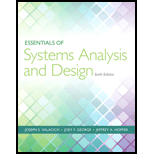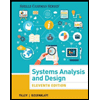
Essentials of Systems Analysis and Design (6th Edition)
6th Edition
ISBN: 9780133546231
Author: Joseph Valacich, Joey George
Publisher: PEARSON
expand_more
expand_more
format_list_bulleted
Expert Solution & Answer
Chapter 3, Problem 16PE
Explanation of Solution
Initial approach to project:
The first step the user need to do is to analyze and take the correct decision...
Explanation of Solution
First activity performed by the user:
After taking the decision to accept a project, the project analysts must visit the...
Explanation of Solution
Required information:
The
Explanation of Solution
Correct person to speak with:
Shop owner is the right person to speak. The program analyst should talk to shop owner ...
Expert Solution & Answer
Want to see the full answer?
Check out a sample textbook solution
Students have asked these similar questions
Plz correct answer by best experts...??
Q3) using the following image matrix
a-
b-
12345
6 7 8 9 10
11 12 13 14 15
1617181920
21 22 23 24 25
Using direct chaotic one dimension method to convert the plain text to stego text (hello
ahmed)?
Using direct chaotic two-dimension method to convert the plain text to stego text?
: The Multithreaded Cook
In this lab, we'll practice multithreading. Using Semaphores for synchronization, implement a
multithreaded cook that performs the following recipe, with each task being contained in a single Thread:
1. Task 1: Cut onions.
a.
Waits for none.
b. Signals Task 4
2. Task 2: Mince meat.
a. Waits for none
b. Signals Task 4
3. Task 3: Slice aubergines.
a. Waits for none
b. Signals Task 6
4. Task 4: Make sauce.
a. Waits for Task 1, and 2
b. Signals Task 6
5. Task 5: Finished Bechamel.
a. Waits for none
b. Signals Task 7
6. Task 6: Layout the layers.
a.
Waits for Task 3, and 4
b. Signals Task 7
7. Task 7: Put Bechamel and Cheese.
a.
Waits for Task 5, and 6
b. Signals Task 9
8. Task 8: Turn on oven.
a.
Waits for none
b. Signals Task 9
9. Task 9: Cook.
a. Waits for Task 7, and 8
b.
Signals none
At the start of each task (once all Semaphores have been acquired), print out a string of the task you are
starting, sleep for 2-11 seconds, then print out a string saying that you…
Chapter 3 Solutions
Essentials of Systems Analysis and Design (6th Edition)
Ch. 3 - An online or hard-copy repository for all project...Ch. 3 - Prob. 2MCh. 3 - Prob. 3MCh. 3 - Prob. 4MCh. 3 - Prob. 5MCh. 3 - Prob. 6MCh. 3 - Prob. 7MCh. 3 - Prob. 8MCh. 3 - Prob. 9MCh. 3 - The process of dividing the project into...
Ch. 3 - Prob. 11MCh. 3 - A graphical representation of a project that shows...Ch. 3 - Prob. 13MCh. 3 - Prob. 14MCh. 3 - A systems analyst with a diverse set of...Ch. 3 - The second phase of the project management...Ch. 3 - Prob. 17MCh. 3 - Prob. 18MCh. 3 - Prob. 19MCh. 3 - Prob. 20MCh. 3 - Prob. 1RQCh. 3 - Prob. 2RQCh. 3 - Prob. 3RQCh. 3 - Prob. 4RQCh. 3 - Prob. 5RQCh. 3 - Prob. 6RQCh. 3 - Prob. 7RQCh. 3 - Prob. 8RQCh. 3 - Prob. 9RQCh. 3 - Describe the steps involved in making a network...Ch. 3 - In which phase of the systems development life...Ch. 3 - What are some reasons why one activity may have to...Ch. 3 - Which of the four phases of the project management...Ch. 3 - What are some sources of risk in a systems...Ch. 3 - Search the Web for recent reviews of project...Ch. 3 - Prob. 16PECh. 3 - Prob. 17PECh. 3 - Prob. 18PECh. 3 - Prob. 19PECh. 3 - Construct a Gantt chart for the project defined in...Ch. 3 - Look again at the activities outlined in Problem...Ch. 3 - Prob. 25PECh. 3 - Prob. 26PECh. 3 - Prob. 27PECh. 3 - Prob. 29PECh. 3 - Prob. 30PECh. 3 - Prob. 31PECh. 3 - Prob. 32PECh. 3 - Prob. 33DQCh. 3 - Do you agree that breaking projects down into...Ch. 3 - Microsoft Project is powerful but expensive....Ch. 3 - When completing a project, some tasks are...Ch. 3 - a. While eating lunch one day, Juanita asked Chris...Ch. 3 - What qualities might Jim possess that would make...Ch. 3 - Prob. 41CQCh. 3 - Prob. 42CQCh. 3 - What should Jim do next to complete the project...Ch. 3 - Prob. 44CQ
Knowledge Booster
Similar questions
- Programming Problems 9.28 Assume that a system has a 32-bit virtual address with a 4-KB page size. Write a C program that is passed a virtual address (in decimal) on the command line and have it output the page number and offset for the given address. As an example, your program would run as follows: ./addresses 19986 Your program would output: The address 19986 contains: page number = 4 offset = 3602 Writing this program will require using the appropriate data type to store 32 bits. We encourage you to use unsigned data types as well. Programming Projects Contiguous Memory Allocation In Section 9.2, we presented different algorithms for contiguous memory allo- cation. This project will involve managing a contiguous region of memory of size MAX where addresses may range from 0 ... MAX - 1. Your program must respond to four different requests: 1. Request for a contiguous block of memory 2. Release of a contiguous block of memory 3. Compact unused holes of memory into one single block 4.…arrow_forwardusing r languagearrow_forwardProgramming Problems 9.28 Assume that a system has a 32-bit virtual address with a 4-KB page size. Write a C program that is passed a virtual address (in decimal) on the command line and have it output the page number and offset for the given address. As an example, your program would run as follows: ./addresses 19986 Your program would output: The address 19986 contains: page number = 4 offset = 3602 Writing this program will require using the appropriate data type to store 32 bits. We encourage you to use unsigned data types as well. Programming Projects Contiguous Memory Allocation In Section 9.2, we presented different algorithms for contiguous memory allo- cation. This project will involve managing a contiguous region of memory of size MAX where addresses may range from 0 ... MAX - 1. Your program must respond to four different requests: 1. Request for a contiguous block of memory 2. Release of a contiguous block of memory 3. Compact unused holes of memory into one single block 4.…arrow_forward
- using r languagearrow_forwardWrite a function to compute a Monte Carlo estimate of the Beta(3, 3) cdf, and use the function to estimate F(x) for x = 0.1,0.2,...,0.9. Compare the estimates with the values returned by the pbeta function in R.arrow_forwardWrite a function to compute a Monte Carlo estimate of the Gamma(r = 3, λ = 2) cdf, and use the function to estimate F(x) for x = 0.2, 0.4, . . . , 2.0. Compare the estimates with the values returned by the pgamma function in R.arrow_forward
- using r languagearrow_forwardusing r languagearrow_forwardYou are given a class that processes purchases for an online store. The class receives calls to: • Retrieve the prices for items from a database • Record the sold items • Update the database • Refresh the webpage a. What architectural pattern is suitable for this scenario? Illustrate your answer by drawing a model for the solution, showing the method calls/events. b. Comment on how applying this pattern will impact the modifiability of the system. c. Draw a sequence diagram for the update operation.arrow_forward
- The images I have uploaded are the part 1 to 4 and questions below are continue on the questions uploaded 5. C++ Class Template with Method Stubs #pragma once #include <iostream> #include <string> #include <stdexcept> #include <vector> template <typename T> class HashTable { private: struct Entry { std::string key; T value; bool isOccupied; bool isDeleted; Entry() : key(""), value(), isOccupied(false), isDeleted(false) {} }; Entry* table; size_t capacity; size_t size; double loadFactorThreshold; size_t customHash(const std::string& key) const { size_t hash = 5381; for (char c : key) { hash = ((hash << 5) + hash) + c; } return hash; } size_t probe(const std::string& key, bool forInsert = false) const; void resize(); public: // Constructor HashTable(size_t initialCapacity = 101); // Big…arrow_forwardthis project is NOT for graded(marks) purposes, please help me with the introduction. give me answers for the project. i will include an image explaining everything about the project.arrow_forwardJava Graphics (Bonus In this lab, we'll be practicing what we learned about GUIs, and Mouse events. You will need to implement the following: A GUI with a drawing panel. We can click in this panel, and you will capture those clicks as a Point (see java.awt.Point) in a PointCollection class (you need to build this). The points need to be represented by circles. Below the drawing panel, you will need 5 buttons: O о о ○ An input button to register your mouse to the drawing panel. A show button to paint the points in your collection on the drawing panel. A button to shift all the points to the left by 50 pixels. The x position of the points is not allowed to go below zero. Another button to shift all the points to the right 50 pixels. " The x position of the points cannot go further than the You can implement this GUI in any way you choose. I suggest using the BorderLayout for a panel containing the buttons, and a GridLayout to hold the drawing panel and button panels. Regardless of how…arrow_forward
arrow_back_ios
SEE MORE QUESTIONS
arrow_forward_ios
Recommended textbooks for you
 Principles of Information Systems (MindTap Course...Computer ScienceISBN:9781305971776Author:Ralph Stair, George ReynoldsPublisher:Cengage Learning
Principles of Information Systems (MindTap Course...Computer ScienceISBN:9781305971776Author:Ralph Stair, George ReynoldsPublisher:Cengage Learning Enhanced Discovering Computers 2017 (Shelly Cashm...Computer ScienceISBN:9781305657458Author:Misty E. Vermaat, Susan L. Sebok, Steven M. Freund, Mark Frydenberg, Jennifer T. CampbellPublisher:Cengage Learning
Enhanced Discovering Computers 2017 (Shelly Cashm...Computer ScienceISBN:9781305657458Author:Misty E. Vermaat, Susan L. Sebok, Steven M. Freund, Mark Frydenberg, Jennifer T. CampbellPublisher:Cengage Learning Systems Analysis and Design (Shelly Cashman Serie...Computer ScienceISBN:9781305494602Author:Scott Tilley, Harry J. RosenblattPublisher:Cengage Learning
Systems Analysis and Design (Shelly Cashman Serie...Computer ScienceISBN:9781305494602Author:Scott Tilley, Harry J. RosenblattPublisher:Cengage Learning Principles of Information Security (MindTap Cours...Computer ScienceISBN:9781337102063Author:Michael E. Whitman, Herbert J. MattordPublisher:Cengage Learning
Principles of Information Security (MindTap Cours...Computer ScienceISBN:9781337102063Author:Michael E. Whitman, Herbert J. MattordPublisher:Cengage Learning Database Systems: Design, Implementation, & Manag...Computer ScienceISBN:9781305627482Author:Carlos Coronel, Steven MorrisPublisher:Cengage Learning
Database Systems: Design, Implementation, & Manag...Computer ScienceISBN:9781305627482Author:Carlos Coronel, Steven MorrisPublisher:Cengage Learning Database Systems: Design, Implementation, & Manag...Computer ScienceISBN:9781285196145Author:Steven, Steven Morris, Carlos Coronel, Carlos, Coronel, Carlos; Morris, Carlos Coronel and Steven Morris, Carlos Coronel; Steven Morris, Steven Morris; Carlos CoronelPublisher:Cengage Learning
Database Systems: Design, Implementation, & Manag...Computer ScienceISBN:9781285196145Author:Steven, Steven Morris, Carlos Coronel, Carlos, Coronel, Carlos; Morris, Carlos Coronel and Steven Morris, Carlos Coronel; Steven Morris, Steven Morris; Carlos CoronelPublisher:Cengage Learning

Principles of Information Systems (MindTap Course...
Computer Science
ISBN:9781305971776
Author:Ralph Stair, George Reynolds
Publisher:Cengage Learning

Enhanced Discovering Computers 2017 (Shelly Cashm...
Computer Science
ISBN:9781305657458
Author:Misty E. Vermaat, Susan L. Sebok, Steven M. Freund, Mark Frydenberg, Jennifer T. Campbell
Publisher:Cengage Learning

Systems Analysis and Design (Shelly Cashman Serie...
Computer Science
ISBN:9781305494602
Author:Scott Tilley, Harry J. Rosenblatt
Publisher:Cengage Learning

Principles of Information Security (MindTap Cours...
Computer Science
ISBN:9781337102063
Author:Michael E. Whitman, Herbert J. Mattord
Publisher:Cengage Learning

Database Systems: Design, Implementation, & Manag...
Computer Science
ISBN:9781305627482
Author:Carlos Coronel, Steven Morris
Publisher:Cengage Learning

Database Systems: Design, Implementation, & Manag...
Computer Science
ISBN:9781285196145
Author:Steven, Steven Morris, Carlos Coronel, Carlos, Coronel, Carlos; Morris, Carlos Coronel and Steven Morris, Carlos Coronel; Steven Morris, Steven Morris; Carlos Coronel
Publisher:Cengage Learning